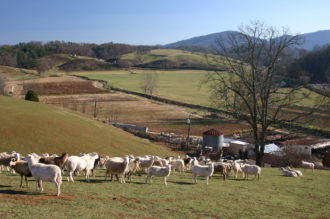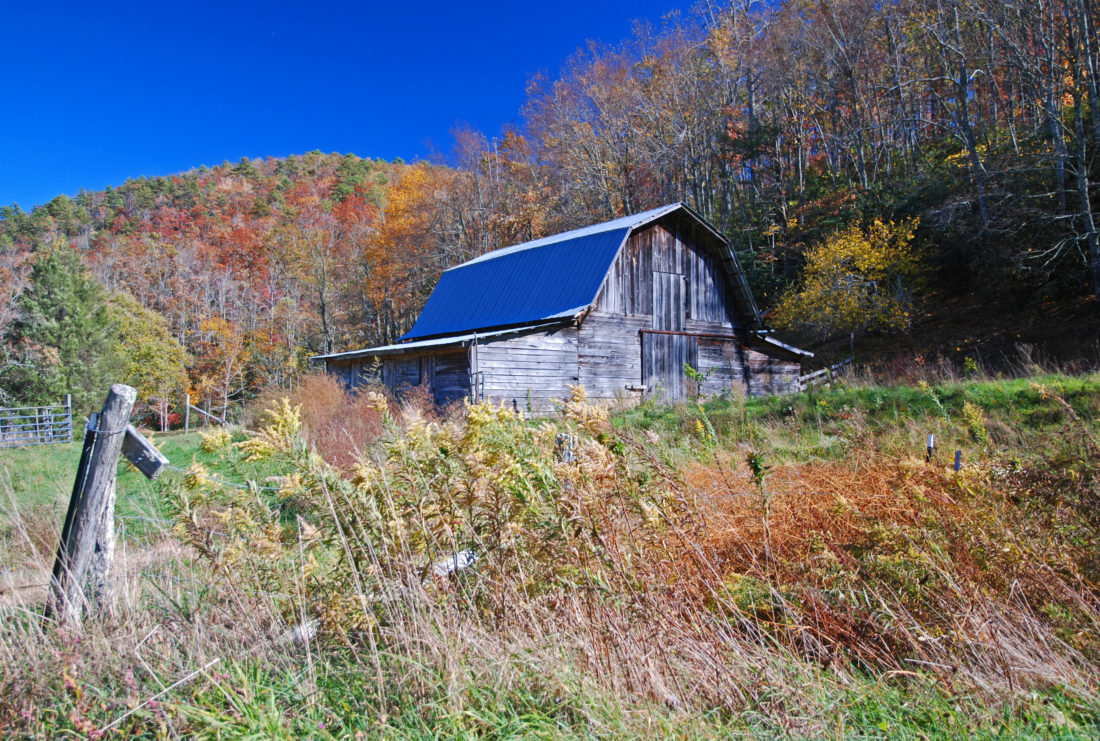One perk of living in Buncombe County is the patchwork quilt of farms that nestles close to Asheville’s urban offerings. Within minutes of leaving downtown, buckets of flowers burst from a U-pick farm in Leicester, and hefty pumpkins still warm from the sun beckon from a Fairview farm stand. But as Buncombe’s popularity — and population — continues to grow, development of farmland poses a threat to the county’s pastoral legacy.
In the early 2000s, Western North Carolina began emerging on the national radar as a highly desirable place to live. During a five-year stretch, housing and commercial development gobbled up more 600,000 acres of farmland statewide, according to U.S. Census of Agriculture data.
The Buncombe County Soil & Water Conservation District Board of Supervisors responded in 2007 by commissioning the county’s first Farmland Protection Plan, a guide to implementing the Farmland Preservation Program established in 1989. Thirteen years later, the county’s agricultural sector has shifted in myriad ways, from the vibrant expansion of direct-to-consumer markets to the gradual evaporation of commodity dairies. To keep up with these changes, the county Board of Commissioners approved a revamped plan in August, designed to support area farmers and balance new housing construction with keeping farmlands intact.
Facts on the ground
The 2007 plan, developed by agricultural consultant Sam Bingham, relied on research, data collection and a survey of local farmers to provide a statistical and anecdotal overview of the county’s agriculture. It also created a list of actionable recommendations for the Buncombe County Farmland Protection Advisory Board to pursue, says Ariel Zijp, who leads the county’s Farmland Preservation Program. “That was really helpful in growing the program that we have,” she explains. “It really built the county’s support of conservation easements and our other preservation programs.”
For the 2020 reboot, local agricultural researcher Smithson Mills gathered input from collaborating agencies such as the Buncombe County Agricultural Advisory Board and N.C. Cooperative Extension, then analyzed the original plan and current data to develop an updated overview of the county’s farming sector. He then surveyed over 350 county landowners and interviewed several in depth to identify pressing issues and compile a new list of recommendations.
One of the most surprising — and encouraging — findings from the updated plan, says Zijp, is that the amount of farmland in Buncombe County has remained fairly constant since 2007, despite consistent population growth and increased development. Between 2007 and 2017, the amount of farmland actually increased slightly from 72,087 acres to 72,284 acres; over that same period, the county’s population went from less than 230,000 to more than 257,000.
Zijp points to those statistics as evidence that the county’s proactive land protection policies have been successful — especially the focus on motivating farmers to seek present-use valuation. (The PUV program allows landowners to pay property taxes at a lower rate based on their land’s farming value rather than its market value for development.) “It’s a really big incentive for people to keep their land together or keep it in ag or forestry,” she says. “If we didn’t have that, we would have seen a significant decrease in farmland.”
Less heartening is the recent decline in economic activity for Buncombe County farmers. Total farm income fell nearly 12% between 2012 and 2017, and average sales per farm dropped almost 13% over the same period. Zijp blames that dip on market shifts, such as falling tomato prices, that have impacted large-scale local producers, as well as the continuing loss of the region’s once-abundant dairies.
“Those are the farms that are bringing in a lot of that income,” she says. “We have so many great markets and things in our area, but you’re seeing the numbers. And that’s one of the great pieces of these plans, is the ability to capture all of that data and see what we can do with it.”
Protection 2.0
Mills identified eight next steps as part of the 2020 plan. Recommendations include ongoing support for existing policies (such as PUV taxation and voluntary agricultural district preservation agreements) and outreach and education about their use. The plan calls for increasing county-level funding and leveraging state, federal and private partnerships to support conservation easements, which preserve property in perpetuity in exchange for tax breaks. County funds are also recommended to encourage new food and farm enterprises and support agricultural economic development.

Covering transaction costs for conservation easements is particularly important for area farmers, says Terri Wells, who helped develop the plan as vice chair of the Buncombe County Agricultural Advisory Board. A ninth-generation farmer from Sandy Mush, Wells works as the director of community and agricultural programs for WNC Communities. (She is also running as a Democratic candidate to represent District 1 on the county Board of Commissioners.)
Wells notes that Zijp’s efforts at raising awareness about the benefits of easements have resulted in a waiting list of farmers eager to participate, but achieving the designation usually takes at least two years. “It takes time, and if we have those funds allotted to where we know we can make that happen, we can just go ahead and get more done,” Wells says.
She would also like to see more county funds for expanded outreach and education — both for farmers and the general public. A virtual discussion Wells hosted in August with N.C. Rep. John Ager (an owner of Hickory Nut Gap Farm in Fairview) and other local farmers about farm stewardship attracted about 70 participants, she reports, showing a clear demand for more information. “It made me feel really positive about the future of farming for our region that there were so many people there who were not farmers, who hadn’t even grown up on farms, who were interested in this,” says Wells.
Awareness about the importance of protecting farmland will become increasingly important over the next 10 years as Buncombe County’s housing market continues to flourish, adds Zijp. “If someone inherits a property, or even if someone purchases a property, we [need to] have the information out there so that they know all their options.”
Growing together
Wells stresses the importance of keeping the county’s remaining farming communities intact so growers can weave support networks for sharing equipment, labor and knowledge. She reflects on a recent evening stroll along her road in Sandy Mush as farmers in neighboring fields mowed hay, picked tomatoes and cut corn silage. “I personally love that, because I just love the sounds, the smell of it,” she says. “But the really important thing is when you have all those farms within one area. It’s much easier to farm.”
Janet Peterson, one of the landowners profiled in the 2020 Farmland Protection Plan, can attest to the significance of maintaining agricultural cohesion. A retired teacher, Peterson inherited her family’s 200-acre farm in Fletcher in 2000 and has since diversified the operation to include beef cattle, rental cabins, honey bees, U-pick blueberries and more.
Since she moved to what is now Cloud 9 Farm as a child in 1968, Peterson has watched the previously robust surrounding enclave of farms gradually decimated by encroaching housing developments. She now laments the loss of like-minded neighbors with whom to share ideas and resources: A nearby field she once rented to grow hay for her cattle, she says, is now a housing subdivision.
But the broader community also suffers from the disappearance of working farms, Peterson notes. “I had somebody today come by to thank me for having a beautiful blueberry patch and having the pastureland with cows on it,” she says. “It’s a relief to the community to see beauty and not just housing developments.”
Cloud 9 takes advantage of PUV taxation and is enrolled as a conservation easement. Without the county’s efforts to preserve farmland, Peterson says, she would likely have been forced to sell her farm years ago. “The pressure of owning an inherited piece of land and having Realtors and developers call me constantly was a lot to bear,” she says. “If I didn’t have the taxes reduced to present-use value for my farm status, I could never afford to live on my family estate.”
Wells echoes the importance of those programs and policies while inviting consideration of the bigger picture. “Farmland is our cropland, our pastureland, but a lot of this farmland that we’ve preserved is forestland, too, which is really important environmentally,” she says. “There’s the importance of the regional food system — that really is key. It’s one of our basic needs. But then there’s the part that speaks to your soul, to your heart, to your quality of life: that we love to have this beauty around us that we enjoy.”






Everyone that has the power to keep those Northenors out of every county in our beautiful Mountains, I beg you to do so, All they want to do is Destroy our Beautiful Mountains, and make millions of dollars and then leave. Thank,s a lot and GOD Bless Everyone.
It is not the Northerners, Mr. Robinson, it is Marxists who are devoted at all levels in taking away property rights, land, children, education (except for marxist re-education) your religious faith and expression, families, and your country and the freedoms and liberties of your Constitution. They come from all over…. the latest two were sent over from Great Britain a few months ago to agitate and money launder for Marxist take over in your town too.